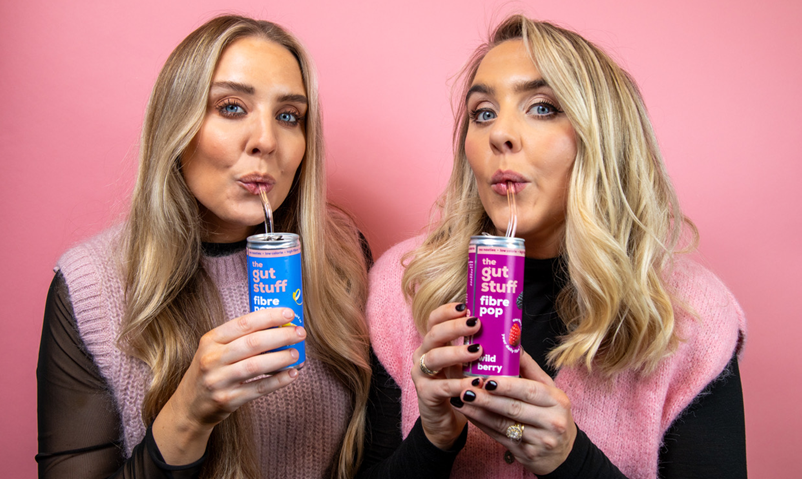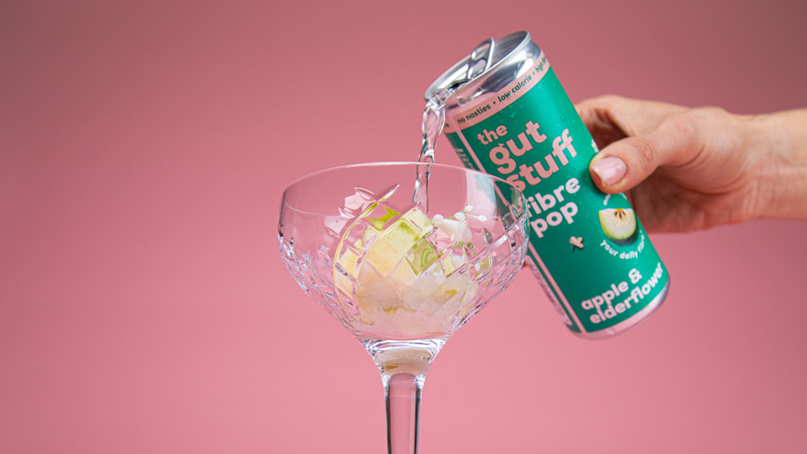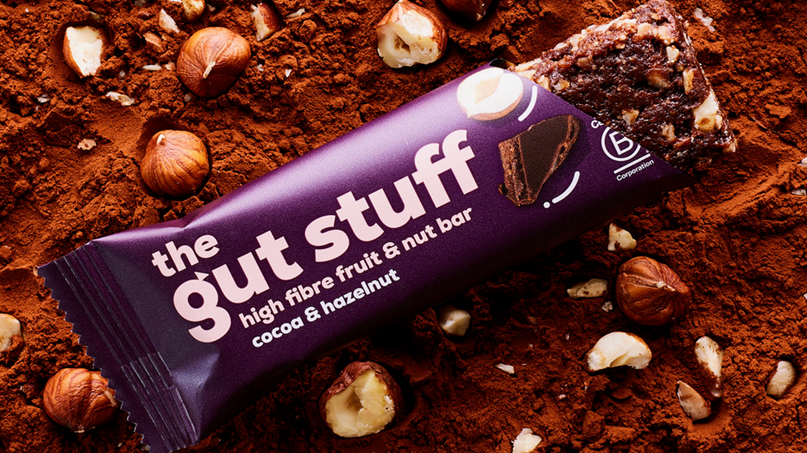
Focused on gut-friendly snacks, drinks and high-fibre products, The Gut Stuff is looking to become a major player in the UK gut health category by breaking down the science behind the microbiome.
Now stocked in UK grocers including Tesco and The Co-op, The Gut Stuff continues to champion the importance of making gut-health products both affordable and accessible.

Discover B2B Marketing That Performs
Combine business intelligence and editorial excellence to reach engaged professionals across 36 leading media platforms.
Speaking ahead of her appearance at the Next Generation Ingredients 2025 conference in London this week, Just Food sat down with co-founder Lisa MacFarlane to discuss changes in consumer habits, The Gut Stuff’s development so far and its international ambitions.
Kristian Bayford (KB): For readers who may not know, could you give a brief introduction to The Gut Stuff came about?
Lisa MacFarlane (LM): My twin sister and I were DJs. We’re from a working-class, Scottish background.
We volunteered for twin research and, as part of that, we had our guts analysed. We were fascinated by what was different between us as identical twins. It turned out that we have only 30% the same gut bacteria, which meant that if we can’t be sold the same diet, no-one can.
But, also, we became fascinated by everything that gut health was linked to, not just digestive health as we know it, but also immunity and mental health.

US Tariffs are shifting - will you react or anticipate?
Don’t let policy changes catch you off guard. Stay proactive with real-time data and expert analysis.
By GlobalDataThis was back in 2017, when gut-health products were often found at the back of health food stores and in expensive aisles. We naively thought: could we democratise this category and help make it mass-market? Since then, what has gone from a passion project has snowballed into The Gut Stuff.
We have three key business areas. The first is the FMCG snack and food business, where we have high-fibre snack bars. We have just launched our high fibre pop drinks, and we’re about to launch new NPD in Q1 next year.
We then have services arms, where we do corporate wellness schemes for Accenture, Aegon and the RAF, where we’re educating workers around the benefits of gut health.
We’ve also got a consumer lifestyle app, which includes trackers and education around gut health.
And then we have a media arm, where we make TV shows. We’ve launched three books globally and we’ve just launched a spin-off show called ‘Chat Shit’. We’re not just a traditional food business, which comes with both positive and negatives.

KB: How would you describe the current state of the gut-health market – and what is The Gut Stuff’s position within it?
LM: We’ve been saying for years that the gut-health wave is coming and it does seem like it’s finally here.
I guess we always wanted to prove that we could take gut health out of cereal and dairy and into the front of store when it came to food and convenience.
We’ve done that recently with The Co-op and Tesco and it feels like we’re now in a position where what we are offering affordable products within a category that previously didn’t exist.
That’s the exciting part for us, as gut health is no longer hidden at the back of the supermarket– now it’s at the front of convenience. Retailers are really helping drive that and it’s no longer seen as a niche.
KB: How would you describe The Gut Stuff’s performance over the last year and which areas of the business have seen the most growth?
LM: We’ve had nearly 100% growth over the last year and we’re about to be announced as one of the 50 fastest-growing companies in the UK, which is crazy.
That growth is mainly in retail and I think that’s a combination of organic growth and brand awareness, as well as performing well in those retailers and getting increased distribution.
For us, it was important that we didn’t pay to play on those accounts. This is a new brand and I think the temptation is to do that to make them work. We knew that we had to really see that organic growth to know that the consumers were ready.
The Co-op and Tesco took the drinks straight off the bat and we just had our first wholesale listing for the drinks as well. I think that recognition of consumer awareness in fibre and convenience is why we’re seeing such growth at this time.
KB: What are the main areas of growth that you’re targeting over the next year?
LM: We plan to double down on those key accounts and big grocery and convenience channels.
We’re launching new NPD in that we’re reformulating the drinks to have three different types of fibre in them. We’ve listened to our audience feedback, and we feel like we should be diversifying the fibre in there. So that’s one of the key levers that we can pull.
A lot of the drinks say they’ve got a lot of fibre in or make high-fibre claims, and there’s hardly any. We’re proud that we’re efficacious.
Even on the app, we’re seeing that when we marry up education and product, we saw a massive uptick in active users due to our fibre challenge when we launched it. If we can continue to kind of marry the physical and digital worlds that we have, that is really driving growth as well.
KB: How is consumer interest in gut health changing and what type of products are they drawn to?
LM: I think snacking is an interesting place for that, because people are looking for swaps, essentially.
The important thing about gut health is that it doesn’t have to be a complete lifestyle change.
We’re thinking stuff like, can you swap something out that had a little bit more fibre? Can you add some more nuts and seeds onto your salad or soup? I think that hopefully that’s where consumers are going to go and that they’re going to stop focusing on magic bullets, detoxes and cleanses.
We hope that those consumers will start switching small snacks and simple habits out to form simple daily gut health habits, rather than thinking that they must cut out gluten, dairy, wine and fun to have good gut health.
The important thing about gut health is that it doesn’t have to be a complete lifestyle change.
I think that diet is only one lever you can pull for good gut health. Sleep, stress, there are so many others that impact it. I think people are starting to take a more holistic wellbeing approach to gut health, rather than cutting out big food groups and paying for expensive testing.
It really has to be small habitual changes and you don’t have to completely revolutionise your lifestyle.

KB: What are your thoughts on the rise of GLP-1 drugs and what impact do you think they are having on consumer behaviour?
LM: GLP-1 is one conversation that’s obviously not going to go away and it’s only going to keep growing.
Consumers are now looking for smaller formats when it comes to food, because they’re obviously eating slightly less but, also, more nutrient dense foods in smaller size portions.
People are really starting to focus on fibre and protein. That’s where drinks really help with that as well, because you can still have functional, nutrient dense products that are drinks, and not just big portions and big meals.
Particularly in hospitality, we’re already seeing portion sizes coming down to accommodate people on these drugs. I think that people are looking for solutions to get the right amount of fibre and hit their protein goals whilst eating less.
Snacking is an interesting place to do that because they’re generally looking for smaller meals over the course of the day.
Of course, we’re advocates but, if you want to take them, do consult a healthcare professional first. It’s scary when these things come out and become so commercialised and how quickly they can change the retail landscape but I do think the landscape is changing, and that, coupled with HFSS regulations, you’ll see a lot of functional, healthier snacks in front of store.
Historically, it’s been very difficult for challenger brands to penetrate that front-of-store space because it’s so competitive but, in Tesco, we’re in the back of store, in dried fruit and nuts sections, as well as in the queue at the front of store.
That was a real turning point for us, and a real proof of point that, in a big convenience grocer, we can be sitting next to confectionery.
KB: Do consumers understand more about their gut health?
LM: We were told that if you make a TV show about gut health, you’ll be on at midnight, on a channel that no one will watch. We had a prime-time slot that nearly 10% the UK population tuned into.
Awareness is definitely increasing and with that comes a big responsibility from brands to educate consumers in the right way. I think there’s a lot of cowboys out there selling snake oil and there’s a lot of big claims.
A lot of us have to work together to say let’s be honest with the consumers about where the science is actually at but also getting over the excitement that this could potentially change the way that you look at health and wellbeing when you look at gut health.
Fibre really is the unsung hero of nutrition that I think is finally getting its moment
For ages, people have been saying that the market’s going to be however many billions by 2025 and I just think consumers are not there yet. I think that because of the protein hype and low carb the kind of demonising of carbs and fibre got lost.
Fibre has so many benefits beyond just digestive health. From heart health, obesity, diabetes and bowel cancer, it really is the unsung hero of nutrition that I think is finally getting its moment. For a few years, we were doubting if the train would ever come and we were so ahead of the game.
When we launched these high-fibre bars, we were having to educate people around fibre, which we still have to do but I feel like now the organic growth we’re seeing is coming from consumers just being more aware of it.

KB: Are there any plans to expand internationally?
LM: There’s still so much to go after in the UK but a lot of our audience on our website is in the US and our books and TV shows are sold and shown in a lot of European countries.
For the international market, we’re getting so much inbound demand for international products. Next year, we are going to be on international shelves, because there is brand awareness there.
That comes with its own challenges, as the TV show and the books are already out in a lot of the countries that we’re going to start playing in. I think it’s important to know that you’ve got a bit of a proof-point before you go in blind.
It’s all just like a steep learning curve but I feel like we have to strike while the iron is hot and while the awareness is growing.
KB: Which countries are you expanding into?
LM: It’s European countries mainly, as well as the US but, for now, we’re just seeing so much growth in the UK that we need to make sure that we can jump on that.
KB: What are your most recent sales and profit numbers and what do you forecast them to be for this financial year?
LM: While we don’t share detailed financials, we’re proud to say we’ve doubled our revenue year-on-year since 2023. We’re continuing to see strong growth across retail, e-commerce, media and workplace wellbeing and we’re excited about what’s ahead this financial year.
KB: What do you see as the main challenges facing those businesses in the gut-health category?
LM: I think the main thing is regulation. A lot of the regulation around what you can and can’t say is very strict and rightly so.
There’s a lot of bullcrap out there, as there’s some consumers that still believe that there’s a magic pill and that celery juice is going to cure them of x, y and z. That’s the main thing to be aware of, as there’s a lot of brands claiming things that just aren’t true.
There’s still a lot of work to be done and no-one in the category can get complacent on that
The second thing is how do we make this mass market? We’re from a working-class Scottish background and we always put everything that we do through the filter of would we have understood this when we were 14? Would we have got it? Would we have cared about this?
I think that people coming into gut health if they’ve got a digestive issue is one thing but making it for everyone is probably the final barrier. Everyone’s got a gut and it’s linked to pretty much every health outcome.
We see from our data and retail that we’re growing across the board, which we’re proud of. There’s still a lot of work to be done and no-one in the category can get complacent on that.
KB: Do you think a lot of consumers underestimate the importance of gut health?
LM: What happens in the gut has a direct link to your mental health. If you see the person you fancy, or you do some public speaking, you get butterflies in your stomach but that connection is bidirectional.
Sometimes, that’s an idea that’s a bit too big for everyone. Because they say ‘gosh, that’s a bit scary’ but it’s empowering, and we should see our gut health as a tool in our armoury for all sorts of things.
As long as people are educating around it in the right way, then it can only be a good thing.
KB: Looking ahead, where do you see The Gut Stuff in the next five years – especially in the context of a fast-changing market and rapidly evolving consumers habits?
LM: We love to be the go-to brand and in the front of consumers’ minds when people think of convenient, simple and accessible gut-health products that’s affordable for everyone.
That means stretching out into new categories, which we’re about to do next year and living by our mission of fighting for a world where everyone knows their guts.
What we’re building with the app, as well as the services business and media business is an ecosystem. We’re starting to see that really come to life.
We want to take consumers on the journey that we’ve been on. That means enabling them to track their gut health, speak to healthcare professionals, buy our products in stores, read our books, and watch a TV show.
I feel like creating that ecosystem was probably a bit too ambitious at the time but now it’s really starting to pay off.





